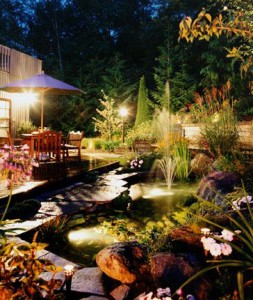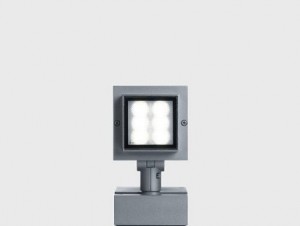Lighting plays an important role in transforming your carefully designed landscape to a magical place at night. For best results you should start to plan for a landscape lighting design when you plan for the garden layout. Planning side by side for both will help to coordinate and also to avoid any mishaps. You can either plan for a simple and elegant landscape lighting layout or you can make it a work of art that blends artificial lights with natural elements to bring out the best in both. Even an ordinary garden that looks dull in daylight can be transformed to vibrant colors and shades at night with proper landscape lighting design. A garden is full of different surfaces with different textures, that when illuminated with the right lighting can set your garden aflame with rich colors.

Careful planning
Once you have planned your garden, go over the objects in them, like trees, sculptures, etc, and decide what objects you want to highlight and what objects you would like to keep bathed in muted lighting. Decide how you want them to be lighted up in contrast to the level ground surrounding the highlighted objects.
Lighting
Basically there are two types of lamps, the spotlight and the floodlight. A spotlight uses a narrow angle lens to focus a bright ray of light to highlight a particular object with laser-like precision, while a floodlight uses a wide angle lens to flood an entire surface with bright light. Floodlighting can be best employed by placing them below a big bush or shrubs and trees to create interesting shadows with the foliage. Spotlights are best to highlight objects of art, like a sculpture or a fountain or a specific plant. The best way to make this work is to fix the spotlight and then move it till you achieve the right amount of lighting on the object you want to highlight.
Color
Color is one of the most important aspects of a landscape lighting design. While white light is most common and brings out the natural colors of plants, colored lights can be employed to enhance or highlight the natural colors of the foliage. A warm yellow light is best to bring out the rich brown hues of tree trunks and its branches. You can also use red or blue light to highlight your foliage.

Water
When highlighted, water shimmers and flickers to create the most magical and interesting patterns. Using proper lighting on water bodies like fountains or miniature waterfalls will be a feast to your eyes and other senses. The most important aspect of a good lighting design is to see that the lighting fixtures are kept out of sight. When a light source is not properly guarded it will produce an unbecoming glare. Make sure to keep these in mind and you can create the most enchanting garden.


0 comments